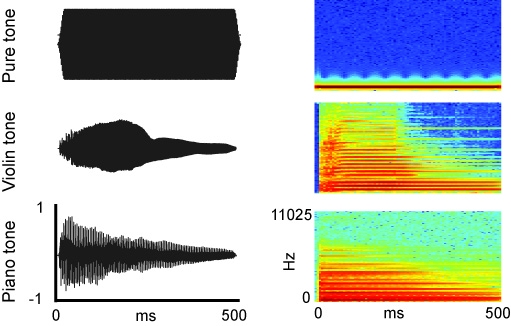Development of Auditory Phase-Locked Activity for Music Sounds
Antoine Shahin - shahin.5@osu.edu
The Ohio State University Eye and Ear Institute,
Department of Otolaryngology-Head and Neck Surgery,
Columbus, OH 43212
Popular version of paper 1pNS6
Presented Monday afternoon, October 26, 2009
158th ASA Meeting, San Antonio, TX
The development of the auditory cortex is influenced by the sounds we hear everyday, mainly speech and music. When we listen to sounds, neurons in our auditory cortex react by firing and relaxing, better known as oscillating. Neural oscillations can be of different rates -- slow (4-14 Hz) to fast (25-70 Hz). As we age, auditory neurons come to show stereotypical response patterns reflecting a preference for familiar over unfamiliar sounds, and their rates of oscillations become specialized for certain sounds' temporal and spectral properties. Temporal and spectral properties of sound are illustrated in Figure 1. Temporal properties of sound include the sound onset rise time (ORT). For example the violin tone has a slower ORT compared to a piano note or a pure tone (left panel). Spectral properties of sound include the richness of sound spectrum (right panel). Both violin and piano tones have richer spectrum than pure tone.

Figure 1. Stimuli: Temporal profile (left panel) and spectrograms (right panel) of pure, violin and piano tones matched in fundamental frequency (A3 American notation, f0 = 220).
One measure of the level of responsiveness of neural activity to sound is the phase-locking index (PLI). PLI represents the strength of temporal (time) alignment of the neural response to physical aspects of sounds such as sound onset. For example, if a sound is presented 100 times and the neural response always occurs at a specific time lag after sound onset, we say that this response represents perfect phase-locking (high PLI). However, if the neural response occurs at different time lags after sound onset, then this neural response is less phase-locked (low PLI).
Using the electroencephalogram (EEG), we measured oscillatory brain activity when individuals between 4 and 25 years of age listened to piano and violin tones, as well as to less familiar and less complex sine tones, termed pure tones (Figure 1). EEG detects the electrical activity of the brain at the scalp. We examined the PLI of different oscillatory activity rates for these sounds as a function of age. We hypothesized that PLI of all rates of neural oscillations in response to the more complex and familiar music sounds will increase as we age, reflecting enhanced tuning of our auditory neurons to preferred sounds.

Figure 2 illustrates some of our results. It shows PLI across six age groups measured at the vertex, a scalp site representing activity originating from the auditory cortex. (1) For slow oscillatory activity, the PLI of all tone types was around the same level before age 10 but abruptly increased between 10-13 years of age, with music sounds exhibiting larger enhancement than pure tones. (2) PLI for fast oscillatory activity exhibited similar developmental trend compared to slow oscillatory activity with the exception that there was no change with development for the less familiar/less complex pure tones -- compare to the large PLI increase with age for music tones. (3) The PLI for slow, but not fast, oscillatory activity exhibited dependence on the ORT of sounds for older age groups (this is observation is not shown in Figure 2). Earlier latencies occurred for sounds with fast ORTs (pure and piano tone) compared to the slow ORT violin tone. Together these findings suggest that music tones become well represented in our auditory memory compared to non-familiar sounds as we age. Also PLI development for fast oscillatory activity reflects specializing for the processing of the spectral but not temporal characteristics of sounds. PLI development of slow oscillatory activity reflects specialization for both temporal and spectral aspects of sounds.
Figure 2. Development of PLI: Development of phase-locking index (PLI) for oscillatory activity of slow (4-14 Hz, top panel)) and fast (25-70 Hz, bottom panel) rates measured at the vertex. Age group PLI means and standard errors are shown.
In conclusion, our finding show that as we age auditory neural responses become more tuned to music sounds, and their rates of oscillation reflect specialization for sounds' temporal and spectral properties. The abrupt PLI change at age 10-13 years is noteworthy, as this may reflect the end of sensitive periods in speech and music acquisition and the full maturation of neural connections in the auditory cortex.
It remains unclear how phase-locking of oscillatory activity beyond age 25 behaves. Questions we would like to explore include whether the PLI for music processing remains strong with advanced age and whether in older age groups music or speech training can strengthen PLI and neural response to these sounds?